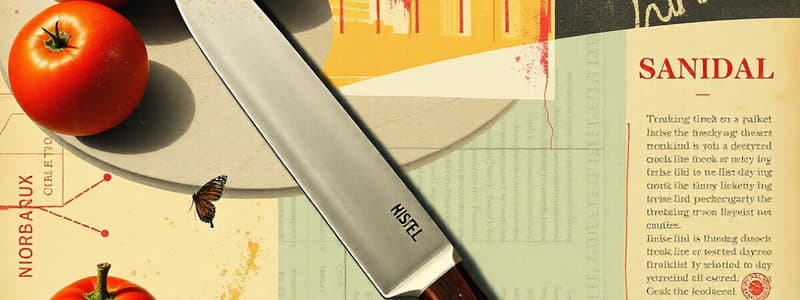Podcast
Questions and Answers
What is the primary reason for cleaning and sanitizing knives after each use?
What is the primary reason for cleaning and sanitizing knives after each use?
- To keep the knives looking new
- To prevent cross-contamination (correct)
- To eliminate the need for sharpening
- To avoid washing dishes
How does proper knife hygiene benefit both food and knife longevity?
How does proper knife hygiene benefit both food and knife longevity?
- It reduces the need for buying new knives.
- It ensures knives have a shiny appearance.
- It makes cutting through tough materials easier.
- It prevents cross-contamination and extends knife lifespan. (correct)
What should you do when switching from cutting raw meat to vegetables?
What should you do when switching from cutting raw meat to vegetables?
- Just rinse the knife with water.
- Wipe the knife on a cloth.
- Use a new knife for the vegetables.
- Sanitize the knife thoroughly. (correct)
What can dirty knives potentially harbor?
What can dirty knives potentially harbor?
Why is it important to clean knives in environments where food is prepared?
Why is it important to clean knives in environments where food is prepared?
What approach is suggested to keep kitchens safe from bacteria?
What approach is suggested to keep kitchens safe from bacteria?
What is an important aspect of knife maintenance beyond hygiene?
What is an important aspect of knife maintenance beyond hygiene?
How does inadequate knife sanitation impact food safety?
How does inadequate knife sanitation impact food safety?
What is the primary purpose of cleaning and sanitizing knives after cutting raw meat?
What is the primary purpose of cleaning and sanitizing knives after cutting raw meat?
What should you use to clean knives to avoid scratching their blades?
What should you use to clean knives to avoid scratching their blades?
Why should knives be sanitized after washing?
Why should knives be sanitized after washing?
What is a recommended practice for maintaining knife cleanliness during food preparation?
What is a recommended practice for maintaining knife cleanliness during food preparation?
What can happen if knives are not cleaned immediately after use?
What can happen if knives are not cleaned immediately after use?
What is a key benefit of regularly sanitizing and maintaining knives?
What is a key benefit of regularly sanitizing and maintaining knives?
What storage method can best maintain the sharpness and safety of knives?
What storage method can best maintain the sharpness and safety of knives?
How often should professional sharpening of knives be done?
How often should professional sharpening of knives be done?
What is the best way to dry a knife after washing?
What is the best way to dry a knife after washing?
Which common mistake should be avoided when sterilizing knives?
Which common mistake should be avoided when sterilizing knives?
What is a disadvantage of using a dishwasher for knives?
What is a disadvantage of using a dishwasher for knives?
After switching between different food types, when should a knife be washed?
After switching between different food types, when should a knife be washed?
Which of the following contributes to a knife's optimal performance?
Which of the following contributes to a knife's optimal performance?
Flashcards
Cross-contamination
Cross-contamination
Transfer of bacteria from one food item to another.
Knife sanitization
Knife sanitization
Cleaning knives to remove harmful bacteria and pathogens.
Food safety
Food safety
Practices that prevent foodborne illnesses.
Proper knife hygiene
Proper knife hygiene
Signup and view all the flashcards
Sanitizing frequency
Sanitizing frequency
Signup and view all the flashcards
Bacterial harboring
Bacterial harboring
Signup and view all the flashcards
Knife maintenance
Knife maintenance
Signup and view all the flashcards
Preventing infections
Preventing infections
Signup and view all the flashcards
Sanitizing knives
Sanitizing knives
Signup and view all the flashcards
Cleaning knives
Cleaning knives
Signup and view all the flashcards
Importance of cleaning
Importance of cleaning
Signup and view all the flashcards
Proper techniques
Proper techniques
Signup and view all the flashcards
Raw meat handling
Raw meat handling
Signup and view all the flashcards
Knife storage
Knife storage
Signup and view all the flashcards
Soaking knives
Soaking knives
Signup and view all the flashcards
Avoiding common mistakes
Avoiding common mistakes
Signup and view all the flashcards
Using dishwashers
Using dishwashers
Signup and view all the flashcards
Regular sharpening
Regular sharpening
Signup and view all the flashcards
Food residue
Food residue
Signup and view all the flashcards
Impact of cleanliness
Impact of cleanliness
Signup and view all the flashcards
Honing rod
Honing rod
Signup and view all the flashcards
Study Notes
Knife Cleaning and Sanitization
- Frequency: Clean and sanitize knives after every use and when changing tasks (e.g., raw meat to vegetables).
- Importance: Prevents cross-contamination, ensures food safety, and maintains a hygienic kitchen.
- Cross-contamination: Occurs when bacteria from one food item transfer to another. Proper cleaning and sanitizing prevent this.
- https://www.kitchenshelp.com/when-must-a-knife-be-cleaned-and-sanitized-natural-solution/
Specific Scenarios
- Raw meat: Knives must be cleaned and sanitized after cutting raw meat, poultry, or seafood to prevent cross-contamination.
- Different food types: Sanitize knives when switching between different food types.
- Extended use: Clean and sanitize knives after extended use.
Cleaning Technique
- Washing: Wash with hot, soapy water using a mild dish soap and a non-abrasive sponge to avoid scratching the blade.
- Rinsing: Rinse off any food debris before washing.
- Sanitizing: Sanitize with a food-safe sanitizer to eliminate lingering bacteria.
- Drying: Properly dry knives to prevent rust and bacteria growth.
Avoiding Damage
- Soaking: Avoid soaking knives, as it may damage the blade or handle.
- Dishwashers: Hand-washing knives is preferable to using dishwashers due to high heat and abrasive detergents.
- Acidic foods: Immediately clean knives after use with acidic foods (e.g., tomatoes, citrus).
Benefits of Proper Cleaning and Sanitization
- Food safety: Prevents foodborne illnesses and ensures food safety.
- Knife longevity: Proper maintenance extends the lifespan of the knife.
- Safety: Prevents accidents.
- Hygiene: Ensures a sanitary kitchen environment.
- Efficiency: A well-maintained knife leads to a smooth cooking process.
Maintaining Knife Sharpness
- Honing: Use a honing rod frequently to realign the blade and maintain sharpness.
- Sharpening: Professional sharpening is recommended every few months to restore sharpness, removing nicks.
Knife Storage
- Safe Storage: Store knives securely to prevent damage and accidents.
- Preventing contamination: Proper storage minimizes bacterial growth and contamination.
Commercial Kitchens
- Critical cleanliness: Maintaining a sanitary commercial kitchen is essential for food safety and hygiene.
- Regular cleaning: Daily and weekly deep cleaning are vital to maintaining cleanliness.
Studying That Suits You
Use AI to generate personalized quizzes and flashcards to suit your learning preferences.




